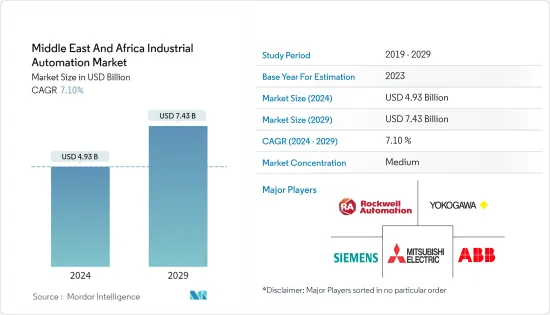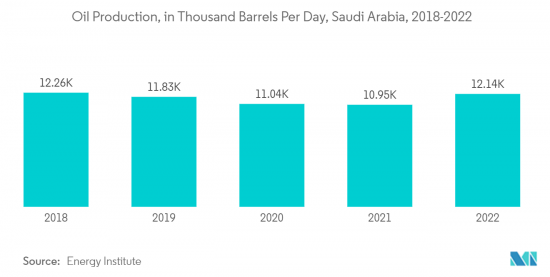PUBLISHER: Mordor Intelligence | PRODUCT CODE: 1408150

PUBLISHER: Mordor Intelligence | PRODUCT CODE: 1408150
Middle East And Africa Industrial Automation - Market Share Analysis, Industry Trends & Statistics, Growth Forecasts 2024 - 2029

The Middle East And Africa Industrial Automation Market size is estimated at USD 4.93 billion in 2024, and is expected to reach USD 7.43 billion by 2029, growing at a CAGR of 7.10% during the forecast period (2024-2029).
The growing active collaboration between governments, regulators, and associations for economic expansion is one of the primary aspects driving growth in the region's automation and manufacturing sectors. For instance, in May 2022, RX Africa announced the Future Manufacturing Africa Trade Fair and Summit 2023, exchanging valuable industry expertise to increase investment prospects in the African continent's manufacturing sector.
Key Highlights
- The UAE Government is focused on doubling the contribution of industrial manufacturing to the country's GDP to 25%, as highlighted in Dubai Industrial Strategy 2030 and Abu Dhabi Economic Vision 2030. Operation 300bn is a government strategy aimed at developing the industrial sector and enhancing its role in stimulating the economy of the UAE. It aims to increase the industrial sector's contribution to the GDP to AED 300 billion (~USD 82 billion) by 2031.
- Furthermore, the Emirates Development Bank (EDB) is a crucial enabler of Operation 300bn. Under the strategy, the bank has allocated AED 30 billion to support priority industrial sectors over five years. Such investments are expected to boost the industrial sector's demand for automated material handling.
- Moreover, rising technological advancements support market growth. In addition, the UAE Ministry of Industry and Advanced Technology and Abu Dhabi defense technology company Edge Group signed an agreement in August 2022 to develop the Emirates' first Industry 4.0 Enablement Centre. The center will help manufacturers beef up their operations by guiding them on using automation, and data-driven business expansion will further drive market growth.
- In February 2022, to fulfill the increased demand for conveying systems in the region, Dubai-based Acme Intralog, a provider of industrial and warehouse automation solutions, stated that it had enhanced the fabrication and manufacturing capabilities of conveyor belts used at its plant in the UAE. The company provides comprehensive conveyor belt solutions for various business sectors, including food and beverage, construction, packaging, textile, and material handling.
- Furthermore, the UAE intends to increase its power generation capacity by approximately 21 GW, with solar power accounting for 26.1% of the total additional generation capacity. These infrastructure developments will likely provide solutions for industrial controls and factory automation.
- However, a higher initial investment cost involved with industrial automation solutions continues to challenge the studied market's growth, especially in the African region, wherein price sensitivity is higher.
- Inflation has a significant impact on industrial manufacturing, as it can lead to higher costs for manufacturers. This can be due to various factors, such as higher prices for raw materials, increased shipping costs, and labor costs and shortages. As a result, manufacturers may be forced to raise their prices to maintain profitability, which can ultimately lead to decreased demand for their products. In addition, inflation can also lead to contract constraints, shifts in labor, and input issues for manufacturers, impacting the studied market's growth.
Middle East And Africa Industrial Automation Market Trends
Penetration in Oil & Gas Industry to Grow Significantly
- In the oil and gas industry, value chain automation is fast becoming essential at exploration sites and production/processing facilities. As oil production/processing often involves the use of different chemicals that can harm humans, automation is a high life saver and is increasingly used in oil production plants to reduce such instances. Furthermore, automation helps companies enhance operational efficiency and production capabilities, driving adoption.
- Countries in the Middle East furnish and export a significant amount of crude oil globally. The area commands considerable demand for industrial sensors used for various applications. According to Baker Hughes rig count, the average rig count in the Middle East increased significantly in 2022 compared to 2021. In 2022, the average number of rigs was 308, an increase of 16.3% compared to 2021.
- The region constantly discovers new oil and gas wells while old and underutilized ones are revitalizing. For instance, the government-owned Abu Dhabi National Oil Co. recently announced a significant rig fleet expansion program expected to add dozens of rigs by 2025. Moreover, ADNOC announced in 2022 that natural gas resources had been discovered offshore the Abu Dhabi Emirates. This is the country's first discovery from its offshore exploration concessions, demonstrating the success of ADNOC's block bid rounds. This exploration discovered 1.5 to 2 trillion standard cubic feet (TSCF) of raw gas.
- According to OPEC, Saudi Arabia holds approximately 17% of the world's proven petroleum reserves. The oil and gas industry contributed roughly 50% of the GDP and 70% of export earnings. According to the Energy Institute, in 2022, oil production in Saudi Arabia was about 12,136 thousand barrels per day. Hence, the country's significant presence in the oil and gas industry will continue contributing to the region's market growth.
- Furthermore, according to a January 2022 report by Arab Petroleum Investments Corporation, energy investments in the Middle East and North Africa are anticipated to increase by 9% over the next five years to more than USD 879 billion as energy exporters increase spending amid higher oil revenue. As automation plays a crucial role in the oil and gas sector, such trends are anticipated to favor the studied market's growth during the forecast period.

Saudi Arabia to Experience Significant Market Growth
- The market in Saudi Arabia is majorly driven by increasing investments in the oil and gas industry value chain. Oil and gas development is transforming other industries, including energy solutions. As a result, like most Middle Eastern countries, Saudi Arabia's economy typically depends on the oil and petrochemical industry; thereby, investments in advanced solutions to maintain the growth of the industries are anticipated to remain high, creating a favorable outlook for the growth of the studied market.
- According to Invest Saudi, agriculture and food processing are among the fastest-growing industries in Saudi Arabia. As the country lacks sufficient arable land, the penetration of advanced farming techniques and production technologies is quickly gaining prominence in the country as the investments by public and private firms are growing significantly. For instance, in June 2023, Saudi's Ministry of Industry and Mineral Resources announced that the government is aiming to attract investments worth USD 20 billion in the food industry by 2035.
- Furthermore, with the strengthening of oil prices, the country is expected to invest more in the non-oil sector, facilitating the rapid growth of the manufacturing and e-commerce sectors. For instance, in February 2023, the Saudi Authority for Industrial Cities and Technology Zones signed a deal to build 14 new high-tech warehouses in the city of Jeddah that will be operated based on a public-private sector partnership model. Owing to such initiatives, the adoption of automation solutions such as automated material handling solutions is expected to witness a higher demand over the forecast period.
- In recent years, owing to Saudi Vision 2030, the plan launched recently to reduce the country's dependence on oil. As a result, sectors such as manufacturing, e-commerce, and logistics sectors are witnessing significant growth. For instance, according to Saudi Arabia's General Authority for Statistics, the country's GDP from Manufacturing increased to SAR 91,760 million (USD 24,462.3 million) in the first quarter of 2023 from SAR 89,976 million (USD 23,986.75 million) in the fourth quarter of 2022. Such trends are anticipated to favor the studied market's growth during the forecast period.
Middle East And Africa Industrial Automation Industry Overview
The Middle East & Africa industrial automation market is moderately fragmented and has the presence of some of the leading automation solution providers. However, the growing penetration of automation solutions is encouraging new players to enter the market, which in turn is anticipated to drive competition among the vendors. Players are involved in product development and strategic activities such as collaborations, partnerships, mergers, and acquisitions. Some key market players include ABB Ltd., Siemens AG, Rockwell Automation, and Yokogawa Electric Corporation.
In June 2023, Schneider Electric opened a new production line in Riyadh to manufacture energy efficiency and sustainability hardware, including intelligent Altivar Process Modular (APM) Drives. According to the company, the new manufacturing facility is equipped with the latest automation technology and robotics.
In April 2023, Honeywell announced its plans to open an advanced regional manufacturing center at the King Salman Energy Park (SPARK), the kingdom's new industrial zone, making it eight in the country. According to the company, the new facility will include engineering, manufacturing, and assembly lines spanning the company's industrial control and automation equipment.
Additional Benefits:
- The market estimate (ME) sheet in Excel format
- 3 months of analyst support
TABLE OF CONTENTS
1 INTRODUCTION
- 1.1 Study Assumptions and Market Definition
- 1.2 Scope of the Study
2 RESEARCH METHODOLOGY
3 EXECUTIVE SUMMARY
4 MARKET INSIGHTS
- 4.1 Market Overview
- 4.2 Industry Attractiveness - Porters Five Forces Analysis
- 4.2.1 Bargaining Power of Suppliers
- 4.2.2 Bargaining Power of Buyers
- 4.2.3 Threat of New Entrants
- 4.2.4 Threat of Substitutes
- 4.2.5 Intensity of Competitive Rivalry
- 4.3 Industry Value Chain Analysis
- 4.4 Impact of Macro Economic trends on the market
5 MARKET DYNAMICS
- 5.1 Market Drivers
- 5.1.1 Increasing Need For Better Inventory Management And Control
- 5.1.2 Rising Incidences of Cyberattacks
- 5.2 Market Challenges
- 5.2.1 Lack of Awareness Regarding Automation
6 MARKET SEGMENTATION
- 6.1 By Solution Type
- 6.1.1 Automated Material Handling Solutions
- 6.1.1.1 Conveyor/Sortation Systems
- 6.1.1.2 Automated Storage and Retrieval System (AS/RS)
- 6.1.1.3 Mobile Robots (Automated Guided Vehicles and Autonomous Mobile Robots)
- 6.1.1.4 Automatic Identification and Data Capture (AIDC)
- 6.1.1.5 Warehouse Management Systems (WMS)/Warehouse Control System (WCS)
- 6.1.2 Factory Automation Solutions
- 6.1.2.1 Industrial Control Systems (DCS, PLC, SCADA, HMI, etc.)
- 6.1.2.2 Field Devices
- 6.1.2.3 Industrial Robotics
- 6.1.2.4 Sensors and Transmitters
- 6.1.2.5 Motors and Drives
- 6.1.2.6 Others
- 6.1.1 Automated Material Handling Solutions
- 6.2 By End Users
- 6.2.1 Automated Material Handling Market
- 6.2.1.1 Manufacturing
- 6.2.1.2 Non-Manufacturing (Warehouses/Distribution Centers/ Logistics Centers)
- 6.2.1.3 General Merchandise
- 6.2.1.4 Healthcare
- 6.2.1.5 FMCG/Non-durable Goods
- 6.2.1.6 Other End Users (Fashion, Durable Goods, and Post and Parcel)
- 6.2.2 Factory Automation Market
- 6.2.2.1 Food and Beverage
- 6.2.2.2 Pharmaceuticals
- 6.2.2.3 Durable Manufacturing
- 6.2.2.4 Textiles
- 6.2.2.5 Other End Users (Pulp and Paper, Water and Wastewater, Chemicals, and Oil and Gas)
- 6.2.1 Automated Material Handling Market
- 6.3 By Country
- 6.3.1 United Arab Emirates
- 6.3.2 Saudi Arabia
- 6.3.3 South Africa
- 6.3.4 Rest of the Middle East
7 COMPETITIVE LANDSCAPE
- 7.1 Company Profiles
- 7.1.1 ABB Limited
- 7.1.2 Siemens AG
- 7.1.3 Yokogawa Electric Corporation
- 7.1.4 Rockwell Automation Inc.
- 7.1.5 Mitsubishi Electric Corporation
- 7.1.6 Honeywell International Inc
- 7.1.7 FLIR Systems Inc.
- 7.1.8 Omron Corporation
- 7.1.9 Tectra Automation
- 7.1.10 Dematic Corporation
- 7.1.11 ACE-Hellas S.A.
- 7.1.12 Saudi Controls Ltd
8 INVESTMENT ANALYSIS
9 FUTURE OF THE MARKET




